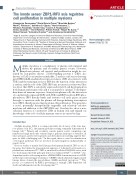Page 165 - 2022_03-Haematologica-web
P. 165
Plasma Cell Disorders
The innate sensor ZBP1-IRF3 axis regulates cell proliferation in multiple myeloma
Kanagaraju Ponnusamy,1 Maria Myrsini Tzioni,1 Murshida Begum,1 Mark E. Robinson,1 Valentina S. Caputo,1 Alexia Katsarou,1,2
Nikolaos Trasanidis,1 Xiaolin Xiao,1 Ioannis V. Kostopoulos,1,3
Deena Iskander,1,2 Irene Roberts,4 Pritesh Trivedi,5 Holger W. Auner,1,2 Kikkeri Naresh,5 Aristeidis Chaidos1,2 and Anastasios Karadimitris1,2
1Hugh & Josseline Langmuir Centre for Myeloma Research, Centre for Haematology, Department of Immunology & Inflammation, Imperial College London, London, UK; 2Department of Haematology, Hammersmith Hospital, Imperial College Healthcare NHS Foundation Trust, London, UK; 3Section of Animal and Human Physiology, National and Kapodestrian University of Athens, Department of Biology, School of Science, Athens, Greece; 4Department of Paediatrics and MRC Molecular Haematology Unit, Weatherall Institute of Molecular Medicine, University of Oxford and BRC Blood Theme, NIHR Oxford Biomedical Centre, Oxford, UK and 5Department of Cellular & Molecular Pathology, Northwest London Pathology, Imperial College Healthcare NHS Trust, London, UK
ABSTRACT
Multiple myeloma is a malignancy of plasma cells initiated and driven by primary and secondary genetic events. However, myeloma plasma cell survival and proliferation might be sus- tained by non-genetic drivers. Z-DNA-binding protein 1 (ZBP1; also known as DAI) is an interferon-inducible, Z-nucleic acid sensor that trig- gers RIPK3-MLKL-mediated necroptosis in mice. ZBP1 also interacts with TBK1 and the transcription factor IRF3 but the function of this interaction is unclear, and the role of the ZBP1-IRF3 axis in cancer is not known. Here we show that ZBP1 is selectively expressed in late B-cell development in both human and murine cells and it is required for optimal T-cell-depen- dent humoral immune responses. In myeloma plasma cells, the interaction of constitutively expressed ZBP1 with TBK1 and IRF3 results in IRF3 phos- phorylation. IRF3 directly binds and activates cell cycle genes, in part through co-operation with the plasma cell lineage-defining transcription factor IRF4, thereby promoting myeloma cell proliferation. This generates a novel, potentially therapeutically targetable and relatively selective myeloma cell addiction to the ZBP1-IRF3 axis. Our data also show a non- canonical function of constitutive ZBP1 in human cells and expand our knowledge of the role of cellular immune sensors in cancer biology.
Introduction
Multiple myeloma (MM) is a common incurable blood cancer of the bone mar- row plasma cells (PC), the immunoglobulin-secreting terminally differentiated B lineage cells.1-3 Primary and secondary somatic genetic events comprising copy number and single nucleotide variants shape a genomic landscape of extensive, in time and space, genetic heterogeneity and diversification rendering targeted ther- apies for MM a challenging task.1-3 In this regard, there is a need for identification of biological pathways that are involved in myelomagenesis independently of genetic status.
Previous studies of murine late B lineage development identified ZBP1 as one of the genes that define the transcriptional signature of follicular B-cell transition to plasmablasts and mature PC.4 ZBP1 is an inducible cellular DNA/RNA sensor with two Zα domains that bind pathogen-derived or cellular Z-DNA5,6 or Z-RNA.7,8 Zα- dependent nucleic acid sensing induces a RHIM-RHIM domain interaction of ZBP1 with receptor-interacting protein kinase 3 (RIPK3) which ultimately triggers mixed lineage kinase domain like pseudokinase (MLKL)-mediated necroptosis.7-10 This process is counteracted by RIPK1, preventing for example ZBP1-dependent cell death and inflammation in the developing skin.11-13
Ferrata Storti Foundation
Haematologica 2022 Volume 107(3):721-732
Correspondence:
ANASTASIOS KARADIMITRIS
a.karadimitris@imperial.ac.uk
Received: October 20, 2020. Accepted: February 2, 2021. Pre-published: February 18, 2021.
https://doi.org/10.3324/haematol.2020.274480 ©2022 Ferrata Storti Foundation
Material published in Haematologica is covered by copyright. All rights are reserved to the Ferrata Storti Foundation. Use of published material is allowed under the following terms and conditions: https://creativecommons.org/licenses/by-nc/4.0/legalcode. Copies of published material are allowed for personal or inter- nal use. Sharing published material for non-commercial pur- poses is subject to the following conditions: https://creativecommons.org/licenses/by-nc/4.0/legalcode, sect. 3. Reproducing and sharing published material for com- mercial purposes is not allowed without permission in writing from the publisher.
haematologica | 2022; 107(3)
721
ARTICLE


